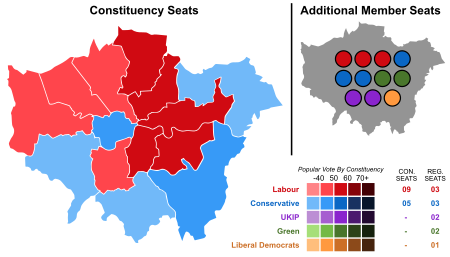Election to the London Assembly 2016
The elections to the London meeting in 2016 took place on May 5, 2016, to select the members of the London Assembly. It took place on the same day as the London mayoral election and local government elections in the United Kingdom. In the last assembly there were four parties: the London Labor Party led by Len Duvall, the London Conservatives led by Gareth Bacon, the London Greens led by Siân Berry and the London Liberal Democrats led by Caroline Pidgeon. Labor received the most votes ever for any party in the London Assembly elections, making it the first party to receive more than 1 million votes. Despite winning Merton and Wandsworth from the Conservatives, their regional vote dropped 0.8% and they closed at 12 noon, the same as in 2012. The Conservative Party only won 8 seats in the assembly, its worst performance yet the London Assembly elections. The Green Party retained its two assembly members, despite its 8.0% share of the regional vote being its worst ever result, and UKIP returned to the London Assembly for the first time since the 2004 election. The Liberal Democrats only voted 1am, their worst result ever. Of the smaller parties, the newly formed Women's Equality Party was the most successful with 91,772 votes (3.51%) on the regional list, which did not give them the right to membership in the assembly, as the threshold for representation was at 5% of the regional votes. No other party polled was above 2%.
choice
The voting system used is called the "Additional Member System"; designated. There are 14 constituencies, each electing one member. These seats were won only by the Labor Party or the Conservative Party. The remaining 11 seats will be distributed by a second vote using a modified D'Hondt method of the closed list with a minimum threshold of 5%. These seats were also won by other parties, namely the Greens, the Liberal Democrats and UKIP and, in the past, the British National Party. The overall result is an attempted compromise between the constituency assembly and the London proportional representation system. Those who were eligible to vote had to be registered to vote before April 19, 2016 in order to vote.
Result
Individual evidence
- ^ Mayor of London and the London Assembly . April 1, 2012. Archived from the original on April 1, 2012.
- ↑ How to register to vote .
